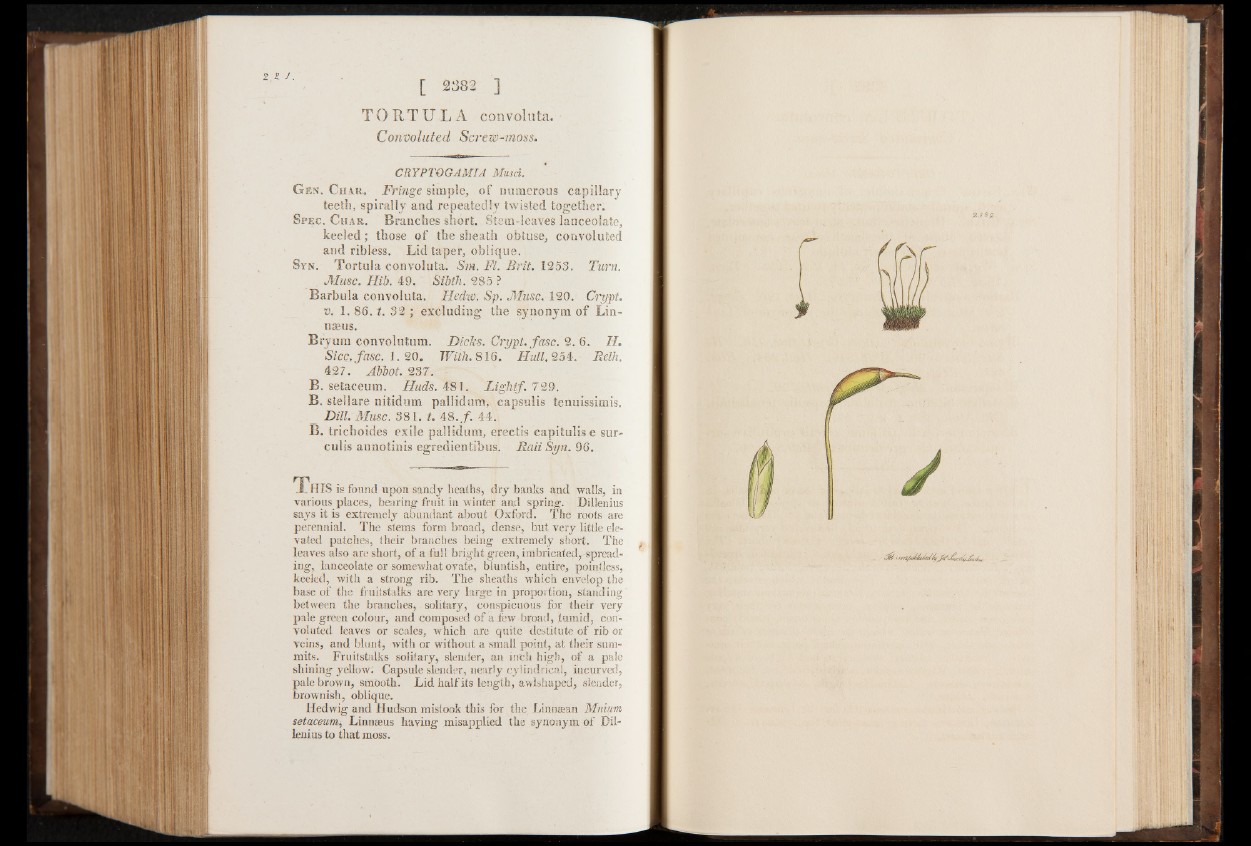
T O R T U L A convoluta.
Convoluted Screw-moss.
CRYPTQGAMIA Musci.
Gen. Char. Fringe simple, o f numerous capillary
teeth, spirally and repeatedly twisted together.
Spec. Char. Branches short. Stem-leaves lanceolate,
keeled; those o f the sheath obtuse, convoluted
and ribless. Lid taper, oblique.
S y n . Tortula convoluta. Sm. Ft. Brit. 1253. Turn.
Muse. Hib. 49. Sibth. 2S5 ?
Barbula convoluta. Hedw. Sp. Muse. 120. Crypt,
v. 1. 86. t. 32 ; excluding the synonym o f Linnaeus.
Bryum convolutum. Dicks. Crypt, fuse. 2. 6 . H.
Sicc.fasc. 1 .2 0 . With. 816. Hull. 254. Belh.
4 2 7 . Abbot. 237.
B. setaceum. Huds. 481. Lightf. 729.
B. stellare nitidum pallidum, capsulis tenuissimis.
Dill. Muse. 381. t. 4 8 .ƒ . 44.
B. trichoides exile pallidum, erectis capitulis e sur-
culis annotinis egredientibus. Raii Syn. 96.
T H I S is found u p o n san d y h e a th s, d ry b an k s a n d walls, in
va rio u s plac es, be arin g fru it in winter an d sp rin g . Dillenius
say s it is ex treme ly a b u n d a n t a b o u t O x fo rd . T h e roots are
p e ren n ia l. T h e stems form b ro a d , dense , b u t v e ry little elev
a te d p a tc h e s , th e ir b ran ch e s b e in g e x trem e ly sh o rt. The
leaves also are sh o rt, o f a fu ll b rig h t green, im b ric a ted r spread-
in g , lanc eola te o r somewhat ovate, b lu n tish , en tire, pointless,
keeled, w ith a stro n g rib . T h e she a ths w h ich envelop the
base o f th e fruitsta lks are very la rg e in p ro p o rtio n , s ta n d in g '
between th e b ranche s, solita ry, co nspicuous for th e ir very
p a le g re en co lour, a n d composed o f a lew b ro ad , tum id , conv
o lu ted leaves o r scales, w h ic h are q u ite de stitute o f rib or
veins, a n d b lu n t, w ith o r w ith o u t a small p o in t, a t th e ir summits.
F ru itsta lk s so lita ry , slender, a n in ch h ig h , o f a pale
s h in in g yellow. Capsule slender, n e arly c y lin d ric a l, incurved,
p a le b rown , smooth. L id h a lf its len g th , awlshaped, slender,
b row n ish , oblique.
H e dw ig a n d H u d so n mistook th is for th e Linnaean Mnium
setaceumi, Linnaeus h a v in g m isap p lied th e sy n o n ym o f Dillenius
to th a t m oss.